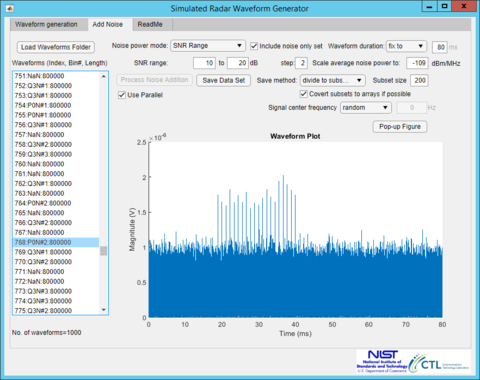ESC Sensor Detection and Placement
NIST has designed deep learning detectors to accurately detect the presence of radar signals for commercial 3.5 GHz sensors. Known as Environmental Sensing Capability (ESC) systems, these sensors are responsible for detecting federal incumbent signals and triggering interference protection mechanisms. NIST is also creating software tools and digital waveforms that can be used by the industry and the regulator to test and certify commercial 3.5 GHz sensors. The digital waveforms are either simulated or derived from radar measurements conducted by NASCTN in the 3.5 GHz band. In addition, NIST has developed algorithms to strategically place the sensors along the coasts effectively and efficiently.
The NIST radar waveform generator software, RF dataset, and the baseline radar detectors are submitted as a use case for IEEE 1900.8 Standard. The use case describes a reference workflow for generating Radio Frequency Machine Learning (RFML) datasets. The IEEE 1900.8 standard aims to standardize the storage format of RFML datasets and the interfaces that connect stages of the RFML model training pipeline. It will also address use cases for RF signal detection, classification, and characterization as well as identification of RF emitters.

More details about ESC sensor detection and placement can be found in the references below:
-
Deep Learning for Radar Signal Detection in the 3.5 GHz CBRS Band (DySPAN 2021)
-
Reference Data Sets for Training and Evaluating RF Signal Detection and Classification Models (GLOBECOM 2019)
-
RF Dataset of Incumbent Radar Signals in the 3.5 GHz CBRS Band (NIST JRES 2019)
-
Detection of Incumbent Radar in the 3.5 GHz CBRS Band Using Support Vector Machines (SSPD 2019)
-
Detection of Incumbent Radar in the 3.5 GHz CBRS Band (GlobalSIP 2018)
-
3.5 GHz ESC Sensor Test Apparatus Using Field-Measured Waveforms (WInnComm 2018)
-
Wideband Spectrum Reconstruction with Multicoset Sub-Nyquist Sampling and Collision Classification (GLOBECOM 2016)
-
A Practical Approach to Placing Coastal Sensors for Spectrum Sharing in the 3.5 GHz Band (WCNC 2019)
-
Sensor Placement and Detection Coverage for Spectrum Sharing in the 3.5 GHz Band (PIMRC 2018)
-
3.5 GHz Environmental Sensing Capability Detection Thresholds and Deployment (TCCN 2017)
-
3.5 GHz Environmental Sensing Capability Sensitivity Requirements and Deployment (DySPAN 2017)
Contacts
RADIO ACCESS AND PROPAGATION METROLOGY GROUP
-
(301) 975-4190
-
(301) 975-6194
-
(301) 975-8617
-
(301) 975-4439

